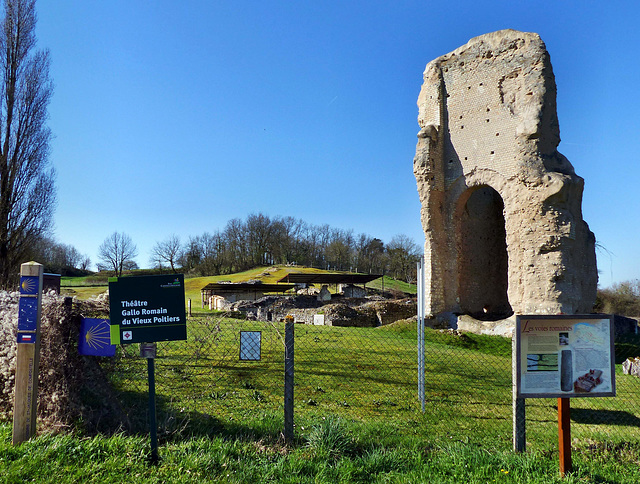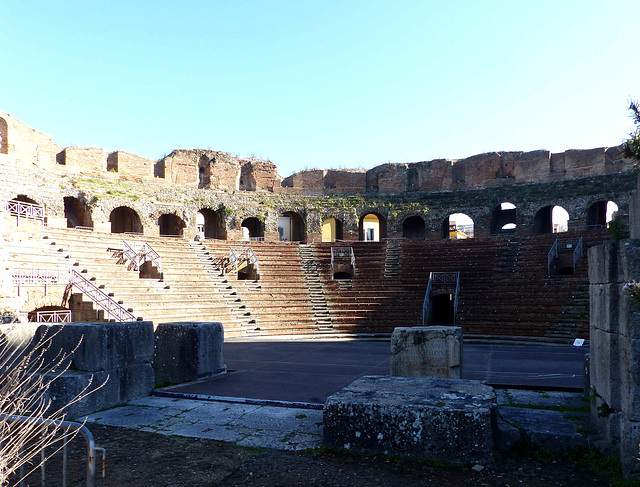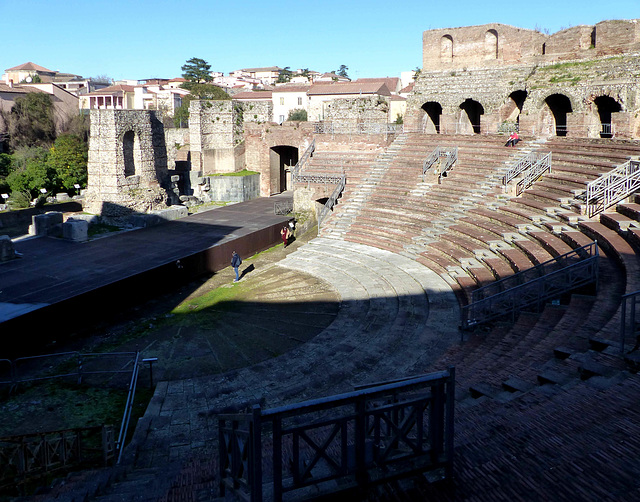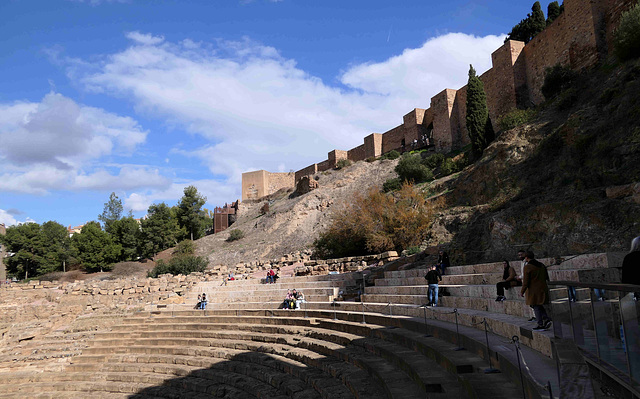
Roman theatres and amphitheatres
Jazz à Vienne / Théâtre Antique
"Jazz à Vienne" features 250 concerts each year, 1,000 artists, 200,000 festival-goers.
The 41st edition took place from June 29 to July 13, 2022.
The main stage of the festival is the "Théâtre Antique" a Roman theater, built in the first century AD. It was rediscovered in 1908, the clearing work was undertaken in 1922. It was inaugurated in 1938. Today, its 46 stands have a capacity of around 8 to 9,000 spectators.
Naintré - Vieux Poitiers
The ruins of the semicircular theatre of "Vetus Pictavis" (aka "Vieux Poitiers"), a Gallo-Roman city, partly excavated by archaeologists. It was founded near the confluence of the rivers Clain and Vienne within the 1. century. The theater had a seating capacity of 10.000. The chemin ("Via Turonensis") is clearly marked - and turns left here.
Benevento - Teatro romano
Due to its location and importance, Benevento was an important base for Roman rule in southern Italy for centuries. After the expansion of the Lombards, Benevento became the seat of Lombard dukes but repeatedly fell into dependence on the Franks and the German emperors. In 840, Benevento was occupied by the Muslims for a few years. The city has been the seat of the Archbishopric of Benevento since 969. In 1047 it fell into the hands of Norman princes with the exception of the city, which Emperor Henry III gave to Leo IX in 1053. In the 11th and 12th centuries, four councils were held in Benevento.
On February 26, 1266, in the Battle of Benevento, the Hohenstaufen Manfred, natural son of the Holy Roman Emperor Frederick II, was defeated by Charles of Anjou, after which the latter seized Apulia, Sicily, and Tuscia.
The Roman theater was built in the 2nd century. Abandoned in Longobard times, it was used for centuries as a quarry to extract building materials, but also to build new houses. The first excavations took place in the 1890s. After the expropriation of the houses built on its walls in the 1930s further excavations were carried out. In 1957 after significant restoration works the theatre became a public monument.
Benevento - Teatro romano
Due to its location and importance, Benevento was an important base for Roman rule in southern Italy for centuries. After the expansion of the Lombards, Benevento became the seat of Lombard dukes but repeatedly fell into dependence on the Franks and the German emperors. In 840, Benevento was occupied by the Muslims for a few years. The city has been the seat of the Archbishopric of Benevento since 969. In 1047 it fell into the hands of Norman princes with the exception of the city, which Emperor Henry III gave to Leo IX in 1053. In the 11th and 12th centuries, four councils were held in Benevento.
On February 26, 1266, in the Battle of Benevento, the Hohenstaufen Manfred, natural son of the Holy Roman Emperor Frederick II, was defeated by Charles of Anjou, after which the latter seized Apulia, Sicily, and Tuscia.
The Roman theater was built in the 2nd century. Abandoned in Longobard times, it was used for centuries as a quarry to extract building materials, but also to build new houses. The first excavations took place in the 1890s. After the expropriation of the houses built on its walls in the 1930s further excavations were carried out. In 1957 after significant restoration works the theatre became a public monument.
Cartagena - Roman theatre
The Iberian predecessor settlement of Cartagena was in 227 BC. naval and military base, de facto the capital of the Carthaginians on the Iberian Peninsula. From here Hannibal set off for Italy at the beginning of the Second Punic War (218 BC). The Romans conquered the city in 209 BC. BC and called it Carthago Nova. Carthago Nova was the most important silver mining region of the Roman Empire. According to Polybius, 40,000 people worked in the silver mines here.
It was destroyed by the Vandals in 425, was probably Visigothic in 475, and Byzantine in 554. Under the name Carthago Spartaria, it was the capital of the Eastern Roman province of Spania before it became Visigoth again in 625. From 711, after the fall of the Visigothic Empire, it became part of the Todmir Empire, and in 756 it became part of the Emirate of Córdoba. Conquered by King James I (Jaime el Conquistador) in 1269, it came to Aragon in the course of the Christian Reconquista, now called Cartagena.
The theater was built around 5 BC. Built. It had a capacity of some 6,000 spectators.
In the 3rd century the theater was rebuilt and a market was built, which was destroyed by Vandals. In the 13th century the Cathedral was built on top of the upper cavea. In 1988 the first remains of the theater were discovered. The archaeological excavations and restorations ended in 2003.
01 Jul 2022
4 favorites
1 comment
Lyon - Fourvière
Colonia Copia Claudia Augusta Lugdunum (now Lyon) was an important Roman city in Gaul. It was the capital of the Roman province of Gallia Lugdunensis. The Christianization took place very early.
In 177, the Christian community sent a letter naming 48 of their number who had been martyred. In 843 it was ceded to Lorraine and then passed to the Kingdom of Burgundy, whose dominion was entrusted to the Archbishop of Lyon by Frederick Barbarossa in 1157. In 1312 Philip the Fair incorporated Lyon into the kingdom of France.
Lyon was the scene of an urban revolt in 1436 when Charles VII increased taxation. The uprising, mainly of small merchants, lasted a total of two months. During the reign of Louis XI. Four fairs were set up, attracting merchants from all over Europe, especially Italy. Lyon became an important center for the spice trade and, more importantly, the silk trade after François I granted the weaving rights, which until then had been an Italian monopoly. Florentine immigrants also made Lyon a financial center for banking and insurance.
-
It is often said that the most beautiful cities are located on rivers. Lyon is situated on two rivers, the Rhone and the Saone, which meet in the south of the city.
-
On the Fourvière hill to the west of the city is a Roman theater that in the summer months is still used today for performances.
Merida - Teatro romano
In the Roman Empire, the city was known as "Emerita Augusta", the capital of the province of Lusitania. It was founded in 25 BC by Emperor Augustus as a colony for the veteran soldiers ("emeritus") of the Roman legions. The city was very important in Roman Hispania. It was endowed with all the comforts of a large Roman city and served as the capital of the Roman province of Lusitania. For centuries, until the fall of the Roman Empire, Mérida was an important economic, military, and cultural center.
Following invasions from the Visigoths, Mérida remained an important city of the Visigothic Kingdom of Hispania in the 6th century. In 713, the Arabs conquered the city and devastated it. Even under Islamic rule, Mérida remained a bishop's seat until it was moved to Santiago de Compostela in 1119.
In 1230 the Christian troops under Alfonso IX conquered Mérida during the Reconquista.
The "Teatro romano de Mérida" was constructed in the years 16 to 15 BCE. It has undergone several renovations, notably at the end of the 1st century or early 2nd century CE when the current facade was erected, and another at the time of Constantine I, which introduced new decorative-architectural elements and a walkway around the monument. Following the theatre's abandonment in Late Antiquity, it was slowly covered with earth.
In its time it had a seating capacity of 6,000. The diameter is about 86 meters.
Málaga - Roman Theatre
Málaga's history spans around 2,800 years, making it one of the oldest continuously inhabited cities in Western Europe. The city was founded around the 8th century BC by seafaring Phoenicians, who called the city Malaka.
From the 6th century BC, the city was under the hegemony of ancient Carthage and from the Second Punic War (218 BC) under Roman rule. The city experienced an economic boom thanks to the production of garum.
The Migration Period meant eventful years for Málaga. After the Vandals and the Alans, Visigoths and Eastern Romans fought for control. In 571, the city was briefly occupied by troops of the Visigothic king Leovigild, but it was not until around 616 that the Eastern Romans finally handed the city over to the Visigoths.
The Moors conquered Málaga in 711 and the city gained importance in the 11th century when the Hammudids established one of their residences here. In 1053, the King of Granada had the last Hammudid caliph poisoned and conquered the city. After the conquest by the Catholic Monarchs in the course of the Reconquista in 1487, "reforms" began to transform the city into a Christian settlement. In Muslim times, the Jewish quarter was located in the eastern part of the city. In the 11th century, the city took in numerous Jews who had fled from the intolerant Berbers in Córdoba. In the middle of the 11th century, around 200 Jews lived in Málaga out of a population of around 20,000. After the city was conquered by Castile in 1487, all of Malaga's Jews were taken prisoner. Around 1490 it was decided that the city should be repopulated by Christians. Jews and Muslims had to leave Málaga within 15 days.
The Roman theatre was built within the 1st century BC, the Alcazaba behind the theater is from the 11th century
Málaga - Roman Theatre
Málaga's history spans around 2,800 years, making it one of the oldest continuously inhabited cities in Western Europe. The city was founded around the 8th century BC by seafaring Phoenicians, who called the city Malaka.
From the 6th century BC, the city was under the hegemony of ancient Carthage and from the Second Punic War (218 BC) under Roman rule. The city experienced an economic boom thanks to the production of garum.
The Migration Period meant eventful years for Málaga. After the Vandals and the Alans, Visigoths and Eastern Romans fought for control. In 571, the city was briefly occupied by troops of the Visigothic king Leovigild, but it was not until around 616 that the Eastern Romans finally handed the city over to the Visigoths.
The Moors conquered Málaga in 711 and the city gained importance in the 11th century when the Hammudids established one of their residences here. In 1053, the King of Granada had the last Hammudid caliph poisoned and conquered the city. After the conquest by the Catholic Monarchs in the course of the Reconquista in 1487, "reforms" began to transform the city into a Christian settlement. In Muslim times, the Jewish quarter was located in the eastern part of the city. In the 11th century, the city took in numerous Jews who had fled from the intolerant Berbers in Córdoba. In the middle of the 11th century, around 200 Jews lived in Málaga out of a population of around 20,000. After the city was conquered by Castile in 1487, all of Malaga's Jews were taken prisoner. Around 1490 it was decided that the city should be repopulated by Christians. Jews and Muslims had to leave Málaga within 15 days.
The Roman theatre was built within the 1st century BC, the Alcazaba behind the theater is from the 11th century
Jump to top
RSS feed- Latest items - Subscribe to the latest items added to this album
- ipernity © 2007-2025
- Help & Contact
|
Club news
|
About ipernity
|
History |
ipernity Club & Prices |
Guide of good conduct
Donate | Group guidelines | Privacy policy | Terms of use | Statutes | In memoria -
Facebook
Twitter










